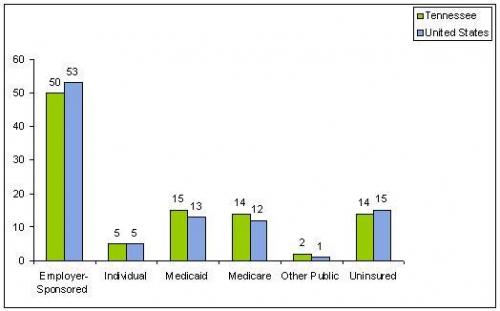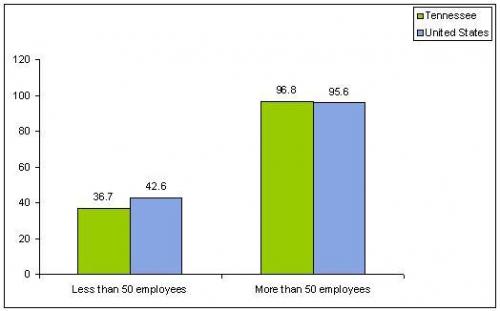To understand the strategies that states undertake to expand coverage and initiate broader health reform, it is important to recognize the variability in states’ health coverage distribution, employer-sponsored insurance rates, and public program eligibility levels. The charts below highlight certain aspects of Tennessee's coverage landscape. The graphs also provide a comparison to national data to give a sense of how Tennessee is faring.
For more information on specific coverage programs implemented in this state, please click on the ‘Coverage Strategies’ tab.
Overview of Medicaid and SCHIP Coverage[1]
Group | Income Eligibility |
185% FPL (ages 0-1) 133% FPL (ages 1-5) 100% FPL (ages 6-19) 250% FPL (SCHIP) | |
Pregnant Women | 250% FPL |
Parents | 137% FPL |
SSI Disabled | 74% FPL |
Sources of Health Insurance Coverage State Data 2006– 2007 U.S.[4]

Percentage of Private-Sector Establishments That Offer Health Insurance Based on Firm Size by State, 2006[5]

[3]Tennessee has covered uninsured and uninsurable (or “medically eligible”) children under its 1115 Medicaid waiver, although those categories are not currently open to new enrollment. Children who have been enrolled in these categories in the past are allowed to continue on the program as long as they continue to meet the criteria under which they were enrolled. Uninsured children whose Medicaid eligibility is ending are allowed to “roll over” into a demonstration category in one of two circumstances: (1) their family incomes are below 200 percent of the FPL, or (2) they have been determined uninsurable (or “medically eligible”). Children in Group 2 can be eligible at any income level.



